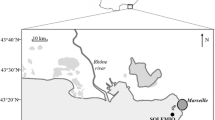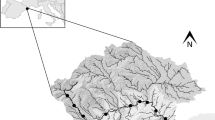Abstract
Fluctuations and interactions of the following microbiological variables and sediment properties were investigated on samples from sandy beaches of the Baltic Sea: bacterial number and biomass, net uptake and respiration rate of 14C-glucose (U), concentration of natural free dissolved glucose and fructose, actual uptake rate and turnover time of glucose, sand-grain size and shape, water and organic matter content of the sediment. Spearman rank correlation analysis demonstrated significant relationships between cell number, biomass and actual uptake rate of glucose. The concentration of natural glucose varied with sand-grain shape, and the uptake rates of glucose were inversely correlated with the water content of the sediment. In the overlying water, cell number and/or biomass were significantly correlated with both concentration and uptake rates of glucose. Partial correlation analysis, however, indicates that, in the water overlying the sediment at least one of the standing crop variables (bacterial number or biomass) is independently variable with uptake activity. The sediment bacterial standing crop does not necessarily reflect metabolic activity. Various significant interactions were noted between mainly sediment properties (water content, organic matter content, grain size) and variables in the water above (cell number, biomass, concentration and uptake rates of glucose).
Similar content being viewed by others
Literature Cited
Azam, F. and O. Holm-Hansen: Use of tritiated substrates in the study of heterotrophy in seawater. Mar. Biol. 23, 191–196 (1973)
Boeyé, A., M. Wayenbergh and M. Aerts: Density and composition of heterotrophic bacterial populations in North Sea sediments. Mar. Biol. 32, 263–270 (1975)
Bölter, M.: Numerical taxonomy and character analysis of saprophytic bacteria isolated from the Kiel Fjord and the Kiel Bight. In: Microbial ecology of a brackish water environment, pp 148–178. Ed. by G. Rheinheimer. Berlin, Heidelberg, New York: Springer-Verlag 1977
—, L.-A. Meyer-Reil and B. Probst: Comparative analysis of data measured in the brackish water of the Kiel Fjord and the Kiel Bight. In: Microbial ecology of a brackish water environment, pp 250–280. Ed. by G. Rheinheimer. Berlin, Heidelberg, New York: Springer-Verlag 1977
Byrnes, B.H., D.R. Keeney and D.A. Graetz: Release of ammonium-N from sediments to waters. Proc. Conf. Gt Lakes Res. (Inst. Sci. Technol., Univ. Mich., Ann Arbor) 15, 249–259 (1972)
Dale, N.G.: Bacteria in intertidal sediments: factors related to their distribution. Limnol. Oceanogr. 19, 509–518 (1974)
Dawson, R. and K. Mopper: A note on the losses of monosaccharides, amino sugars and amino acids from extracts during concentration procedures. Analyt. Biochem 83 (In press) (1978)
Erkenbrecher, C.W. and L.H. Stevenson: Factors related to the distribution of microbial biomass in salt-marsh-creeks. Mar. Biol. 40, 121–125 (1977)
Fliermans, C.B. and E.L. Schmidt: Fluorescence microscopy: direct detection, enumeration and spatial distribution of bacteria in aquatic systems. Arch. Hydrobiol. 76, 33–42 (1975)
Gunkel, W.: Die Verwendung des Ultra-Turrax zur Aufteilung von Bakterienaggregaten in marinen Proben. Helgoländer wiss. Meeresunters. 11, 287–295 (1964)
Hall, K. J., P.M. Kleiber and I. Yesaki: Heterotrophic uptake of organic solutes by microorganisms in the sediment. Memorie Ist. ital. Idrobiol. 29 (Suppl.), 441–471 (1972)
Hargrave, B. T.: Aerobic decomposition of sediment and detritus as a function of particle surface area and organic content. Limnol. Oceanogr. 17, 583–596 (1972)
Harrison, M.J., R.T. Wright and R.Y. Morita: Method for measuring mineralization in lake sediments. Appl. Microbiol. 21, 698–702 (1971)
Hickel, W. und W. Gunkel: Untersuchungen über die Häufigkeit der Bakterien in der obersten Sedimentschicht der Deutschen Bucht in Beziehung zu den Substrateigenschaften. Helgoländer wiss. Meeresunters. 18, 213–231 (1968)
Hobbie, J.E. and C.C. Crawford: Respiration corrections for bacterial uptake of dissolved organic compounds in natural waters. Limnol. Oceanogr. 14, 528–532 (1969)
Jacobsen, O.S. and S.E. Jørgensen: A submodel for nitrogen release from sediments. Ecol. Modelling 1, 147–151 (1975)
Jeffay, H. and J. Alvarez: Liquid scintillation counting of carbon-14. Use of ethanolamineethylene glycol monomethyl ether-toluene. Analyt. Chem. 33, 612–615 (1961)
Jones, G.E. and H.W. Jannasch: Aggregates of bacteria in sea water as determined by treatment with surface-active agents. Limnol. Oceanogr. 4, 269–276 (1959)
Jørgensen, S.E., L. Kamp-Nielsen and O.S. Jacobsen: A submodel for anaerobic mud-water exchange of phosphate. Ecol. Modelling 1, 133–146 (1975)
Josefsson, B.O.: Determination of soluble carbohydrates in seawater by partition chromatography after desalting by ion-exchange membrane electrodialysis. Analytica chim. Acta 52, 65–73 (1970)
Kamp-Nielsen, L.: Mud water exchange of phosphate and other ions in undisturbed sediment cores and factors affecting the exchange rates. Arch. Hydrobiol. 73, 218–237 (1974)
Litchfield, C.D., J.B. Rake, J. Zindulis, R.T. Watanabe and D.J. Stein: Optimization of procedures for the recovery of heterotrophic bacteria from marine sediments. Microb. Ecol. 1, 219–233 (1975)
Meadows, P.S. and J.G. Anderson: Micro-organisms attached to marine and freshwater sand grains. Nature, Lond. 212, 1059–1060 (1966)
Meyer-Reil, L.-A.: Bacterial growth rates and biomass production. In: Microbial ecology of a brackish water environment, pp 223–236. Ed. by G. Rheinheimer. Berlin, Heidelberg, New York: Springer-Verlag 1977
—: Uptake of glucose by bacteria in the sediment. Mar. Biol. 44, 293–298 (1978)
Rheinheimer, G.: Bakteriologisch-ökologische Untersuchungen in Sandstränden an Nord- und Ostsee. Botanica mar. 20, 385–400 (1977)
Sachs, L.: Angewandte Statistik, 545 pp. Berlin, Heidelberg, New York: Springer-Verlag 1974
Smetacek, V., B. von Bodungen, K. von Bröckel and B. Zeitzschel: The plankton tower. II. Release of nutrients from sediments due to changes in the density of bottom water. Mar. Biol. 34, 373–378 (1976)
Stevenson, L.H., C.E. Millwood and B.H. Hebeler: Aerobic, heterotrophic bacterial populations in estuarine water and sediments. In: Effect of the ocean environment on microbial activities, pp 268–285. Ed. by R.R. Colwell and R.Y. Morita. Baltimore: University Park Press 1974
Van Slyke, D.D., J. Plazin and J.R. Weisiger: Reagents for the Van Slyke-Folch wet carbon combustion. J. biol. Chem. 191, 299–304 (1951)
Weise, W. and G. Rheinheimer: Scanning electron microscopy and epifluorescence investigation of bacterial colonization of marine sand sediments. Microb. Ecol. (In press). (1978)
Westheide, W.: Zur quantitativen Verteilung von Bakterien und Hefen in einem Gezeitenstrand der Nordsseküste. Mar. Biol. 1, 336–347 (1968)
Williams, P.J. LeB.: Heterotrophic utilization of dissolved organic compounds in the sea. I. Size distribution of population and relationship between respiration and incorporation of growth substrates. J. mar. biol. Ass. U.K. 50, 859–870 (1970)
Wood, L.W.: The role of estuarian sediment microorganisms in the uptake of organic solutes under aerobic conditions, 75 pp. Ph. D. Thesis, North Carolina State University at Raleigh 1970
ZoBell, C.E.: Studies on the bacterial flora of marine bottom sediments. J. sedim. Petrol. 8, 10–18 (1938)
Author information
Authors and Affiliations
Additional information
Communicated by O. Kinne, Hamburg
Publication No. 206 of the “Joint Research Program” at Kiel University (Sonderfor-schungsbereich 95 der Deutschen Forschungsgemeinschaft).
Rights and permissions
About this article
Cite this article
Meyer-Reil, L.A., Dawson, R., Liebezeit, G. et al. Fluctuations and interactions of bacterial activity in sandy beach sediments and overlying waters. Mar. Biol. 48, 161–171 (1978). https://doi.org/10.1007/BF00395016
Accepted:
Issue Date:
DOI: https://doi.org/10.1007/BF00395016




